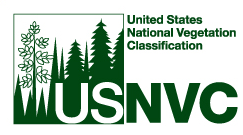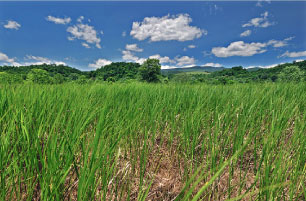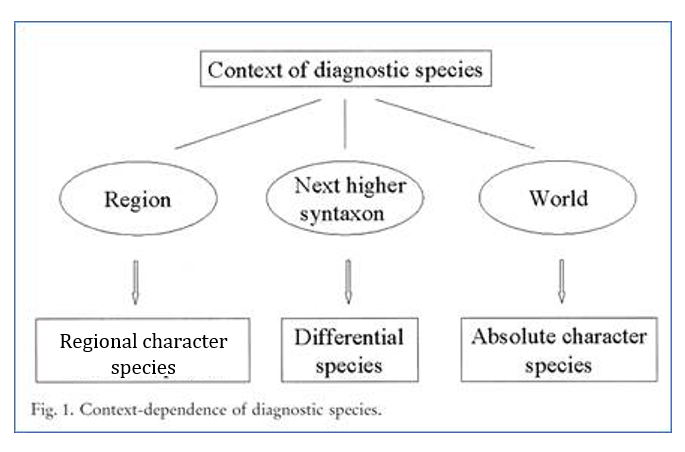


| Content |
|---|
The United States National Vegetation Classification (USNVC)  is a dynamic classification, open to revisions as new ecological knowledge becomes available. Authors can submit editorial changes and proposed revisions to the USNVC Review Board, which maintains an editorial and peer review process for these submissions (the Board is overseen by the ESA Panel on Vegetation Classification). The Proceedings of the USNVC serves as the official record of approved revisions to the classification, and contains published manuscripts and reports that document the reasoning and evidence behind those changes.
is a dynamic classification, open to revisions as new ecological knowledge becomes available. Authors can submit editorial changes and proposed revisions to the USNVC Review Board, which maintains an editorial and peer review process for these submissions (the Board is overseen by the ESA Panel on Vegetation Classification). The Proceedings of the USNVC serves as the official record of approved revisions to the classification, and contains published manuscripts and reports that document the reasoning and evidence behind those changes.
For Editorial Review, authors will typically download the Editorial Review Submission Form [add link], and attach any existing type descriptions. They will edit the type description, with track changes on, and explain the problem and solution. Guidelines for the form are also available. [add link]
Background: Peer review submissions typically depend on data and information derived from standard plot data gathering, inventory, and analysis methods used for ecological vegetation classifications, such as the USNVC. Authors should be familiar with these basic vegetation ecology methods used by the USNVC (see Jennings et al. 2009, Faber-Langendoen et al. 2014).
Original submission. Provide information describing the extent to which data or text in the proposal have been used in other works that are published, in press, submitted, or soon to be submitted.
Data Policy. Authors are expected to make the plot data that support a proposal available through a public database, preferably VegBank (i.e. data are uploaded into VegBank [contact Michael_Lee@ natureserve.org] or managed in a web-accessible institutional or organizational database, or readily available on request through an institution or organization).
Include computer code. Authors must provide any novel computer code for models, simulations, or statistical analyses used to support proposals.
Author profiles. Authors are responsible for modifying their profile to keep the editors and staff informed of changes in their contact information. The corresponding author will be notified of receipt of the manuscript (see below). Do not add the email address of a co-author as a secondary email address.
English. Authors whose native language is not English are encouraged to enlist the aid of a native English-speaking colleague to review the proposal for correct usage and clarity prior to submission.
Consult recent issues of the USNVC Proceedings for examples of style [add link]. For purposes of review, submitted proposals must adhere to the standard submission guidelines. Be sure to abide by the following minimum formatting requirements for submitted proposals:
Appendices and Supplements should be in files separate from the manuscript (and not merged with the manuscript file).
Tables and figures may be in a separate file or in one file together with the manuscript text. If figures are in a separate file, please provide a separate file with all the figure legends (or include it in the manuscript file).
A standard USNVC Type Description Template must be used for all Type Descriptions [see attachment and guidance]. See also “Formatting your Proposal.”
If you are revising existing types already published in the USNVC (see usnvc.org), you may start your revisions process by request a template-based report from the USNVC Data Manager (currently Mary Russo; mary_russo@natureserve.org). That report will contain the full description of the published content of a type (or types). It typically includes descriptions for higher level types as well.
The following questions are used by the NVC Review Board and Peer Reviewers to gauge the quality of Manuscript Submissions. We provide them here, so Authors may be guided by them when drafting their submissions. The criteria are written for a type, but apply equally to multi-type submissions.
| Criteria | Checklist |
|
1. Number of plots or field observations. Does the proposal add to the number of plots describing the concept(s), and/or is the concept well-grounded in field observations?
|
|
|
2. Site Selection. Is the selection of sites and plot locations well documented, including e.g. documentation relating to naturalness, natural disturbances, succession, human impacts? |
|
|
3. Spatial. To what degree do the plots cover a large portion of the expected range of the type? Confidence increases as the portion increases. |
|
|
4. Analytical methods – is the research repeatable and does it follow the principles of the NVC– a practical, rigorous ecological vegetation classification (see box below)? See FGDC 2008, Peet and Roberts 2013, Faber-Langendoen et al. 2014 for methodology and analysis guidance. |
|
|
5. Is the type concept both clearly distinguished from other types and is it a practical type concept (See box of NVC principles below):
The more the above criteria collectively document the distinguishing characteristics of a type, separating it from other types, the greater the confidence in the type. |
|
|
6. Does the type concept fit the criteria for the level that is being proposed (see FGDC 2008, and Faber-Langendoen et al. 2014 for criteria for each level) and does it fit with the next higher level it is proposed to be placed in? (e.g., proposed association fits the association criteria and fits into the assigned alliance). |
|
|
7. General description:
|
The Steps in the Process
Checking the manuscript status: You can check the status of your submission with the Scholastica website [website forthcoming].
See FGDC 2008 and Faber-Langendoen et al. (2014). Various supporting analytical techniques may be used. See especially Peet and Roberts (2013, section 2.6 and 2.7).
When considering whether a species is differential, specify the other types that are being compared and how the differential strength was determined. A common context would be among types within a higher type (associations within an alliance, alliances within a group). Thus, the differential species help distinguish a vegetation type among types within a higher vegetation type. The more that a species also reflects diagnostic value among any type in a region (and thus less dependent on hierarchical context), the stronger the differential strength (i.e. they become regional or even global character taxa). (from Willner 2006).

For example, longleaf pine (Pinus palustris) may not be a good differential for associations with a longleaf pine alliance or even group, though it is typically a good dominant and constant in those types. Various groundlayer or shrub species (such as Aristida stricta) are differentials at the association or alliance level. But longleaf pine is a very strong differential, or character species at the macrogroup level because it not only differentiates the macrogroup from other macrogroups within its division, but also from any other macrogroup in any other division.
It is difficult to provide guidance on how best to document the differentiating ecological characteristics. In some cases it may be site factors, such as texture, alkalinity, slope, aspect, flooding or saturation. In other cases it may be the disturbance regime, such that distinctive types (e.g. a sagebrush type and a pinyon-juniper type) may occur on essentially the same site conditions, but have different fire or grazing regimes. In this case, it will be important to note both the overlap in site factors and the distinctive disturbance regime that corresponds with the diagnostic features of the type.
Use the standard USNVC template to revise existing type or describe new types.
Faber-Langendoen, D., T. Keeler-Wolf, D. Meidinger, D. Tart, B. Hoagland, C. Josse, G. Navarro, S. Ponomarenko, J.-P. Saucier, A. Weakley, P. Comer. 2014. EcoVeg: A new approach to vegetation description and classification. Ecological Monographs 84:533-561 (erratum 85:473).
FGDC (Federal Geographic Data Committee). 2008. FGDC-STD-005-2008. National Vegetation Classification Standard, Version 2. Vegetation Subcommittee, U.S. Geological Survey, Reston, VA. 55 pp. + Appendices.
Peet, R.K., and D.W. Roberts. 2013. Classification of natural and semi-natural vegetation. Chapter 4, In J. Franklin and E. van der Maarel, editors. Vegetation Ecology. 2nd edition. Oxford University Press, New York, NY.
Willner, W. 2006. The association concept revisited. Phytocoenologia 36:67-76.
| Regional Editor | Region | |
| West | Este Muldavin | Warm Desert |
| Todd Keeler-Wolf | Californian | |
| Marion Reid | Cool Semi-Desert | |
| Del Meidinger | Vancouverian (Pacific Coastal) | |
| Jack Triepke | Rocky Mountain | |
| Great Plains | Bruce Hoagland | Great Plains |
| East | Don Faber-Langendoen | Laurentian-Acadian |
| TBD | Central Interior-Midwest | |
| Lesley Sneddon | Appalachian-Northeast | |
| Alan Weakley | Southeast Coastal Plain | |
| Caribbean | Humfredo (Fito) Marcano | Caribbean |
| Boreal | Beth Schulz (interim) (US) / Kim Chapman (CA) | Boreal-Subarctic |
| Arctic | Scott Guyer (US) / TBD (CA) | Western Arctic / Alpine |
| TBD (US / TBD (CA) | Eastern Arctic / Alpine |